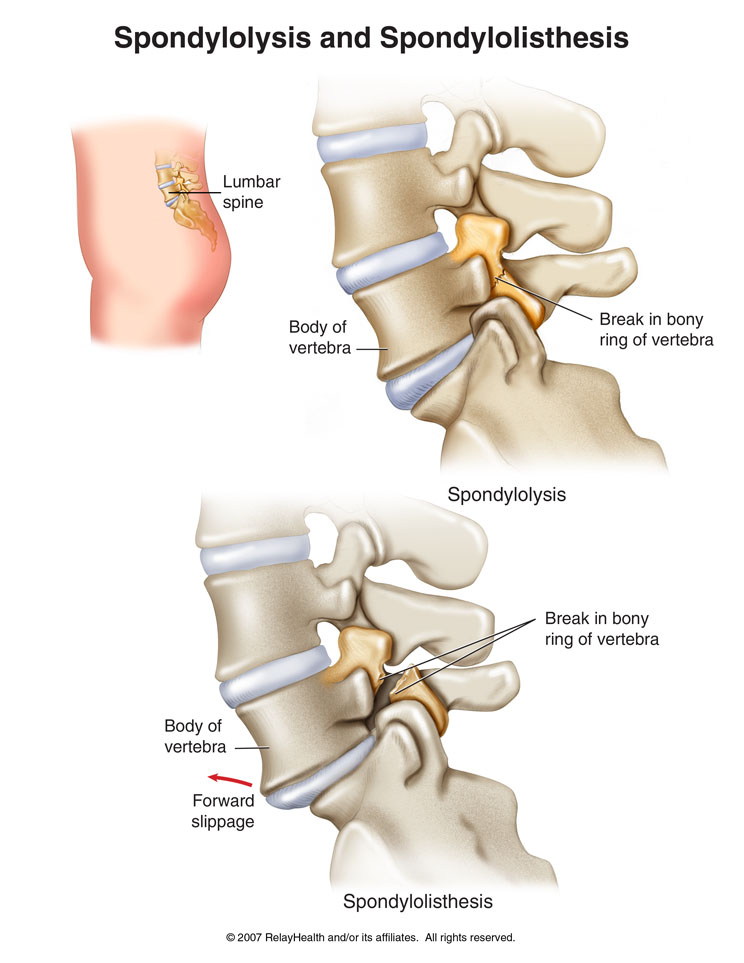Spondylolysis and Spondylolisthesis
One of the most common causes of lower back pain in adolescents who are involved in athletics is a stress fracture of the vertebra in the lumbar region of the spine, which can be seen on an x-ray. The stress fracture(s) in this particular region of the spine is known as spondylolysis.
If the stress fracture weakens the vertebra so much that it cannot support or maintain it's proper position, shifting them out of place, it is no longer spondylolysis, but another condition -- spondylolisthesis. It is likely that the shifting of these vertebras can press on the spinal nerves, causing pain and a limited amount of motor function such that surgery may be required to correct the condition.
Your physician will conduct a physical examination to determine where in the lower back the tenderness and pain occur. Then, he or she may order an x-ray of your lower back to view the position of the vertebra in the lumbar spine to confirm that there are fractures of slippage, confirming the diagnosis of spondylolysis (for fractures) or spondylolisthesis (shifting of vertebra forward).
In a posterior cervical foraminotomy, your physician will, from the back of the neck, relieve the pressure on the spinal nerves by cutting or shaving away parts of the open to open the nerve root opening (foramen) in the lumbar area, where the spinal nerves branch out to the lower extremities.
Laminectomy
A laminectomy removes the lamina, two small bones that make up a vertebra. This is another procedure that is used to relieve pressure placed on the spinal nerves. By removing the bones, more space is created in the spinal column, giving the nerves more room.
Spinal fusion
A spinal fusion may be performed after aforaminotomy or a laminectomy to further stability. This surgery will fuse together two vertebral bones together, one on top of another, so that there is no longer any movement between them. This fusion can be done with screws, plates, or cages. Depending on your individual medical history and current health status, our spine specialists may recommend an artificial disc replacement instead of a spinal fusion.
Genetics
Individuals who develop these conditions may have been born with a thin vertebrae that is susceptible to stress fractures Periods of rapid growth can also put pressure on the vertebrae, increasing the risk of stress fractures Overuse Participating in some sports, can put a tremendous amount of stress on the bones in the lower back. These include: ballet, gymnastics, lifting weights, and contact sports.
Stress fractures seen in spondylolysis are due to constant flexing or overstretching of the spine.
Many who have spondylolysis and spondylolisthesis do not exhibit any obvious symptoms.
Pain usually spreads across the lower back and may feel like a muscle strain.
Spondylolisthesis can cause spasms that stiffen the back and tighten the hamstring muscles
This can change your posture and gait.
Nonsurgical treatment
Physicians seek to treat spondylolysisnon surgically before resorting to surgical treatments.
Your physician will recommend that you take a break from your normal activities and suggest that you take anti-inflammatory medications that may reduce your back pain.
A back brace or physical therapy may be recommended by your physician. Stretching and strengthening exercises for the back and abdominals can help prevent future injuries.
Spinal Fusion
This surgery will fuse together two vertebral bones together, one on top of another, so that there is no longer any movement between them. This fusion can be done with screws, plates, or cages. Depending on your individual medical history and current health status, our spine specialists may recommend an artificial disc replacement instead of a spinal fusion.

